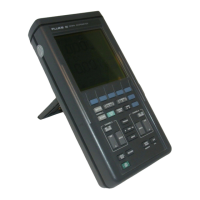CIRCUIT DESCRIPTIONS 3-31
The configuration depends on
the settings of switches D2650 and D2751. These switches are
controlled by the signals FILT CALDC- HD, SQUAR and Si. Table 3.8 lists ttie various settings and
resulting generator
output
signals.
Table 3.8 Generator control signals for various generator output signals.
STIMUL CONTROL SIGNALS OUTPUT
SIGNAL
I
frequency duty CALDC- RLT SCXJAR SI amplitude waveform
'
cycle HD
1
488 Hz 50% 0 0 1 1
976 Mz 50% 0 0 1 1 Square wave vonage
1.95 KKz 50% 0 0 1 1
-
1 0 0 1 3Vp-p DC voltage
976 Hz 50% 0
1 1
1 Vp-p Sine wave voltage
20 kHz
0-100%
0 1 0 1
•2...+2VP-P
Slow ramp voltage
20
kHz 0-100%
0 1 0 0 0...+3 mA Slow ramp current
In this table "V means: signal "high* (switch closed) and
*'0"
means signal
"low*
(switch open).
The slow ramp current signal is made with a current source. A simplified
schema^c
diagram
is
given
in figure 3.17;
Figure 3.17 Current source section of generator
When
the duty
cycle
of STIMUL Is0%, the bridge will be In balance and current
1^
=
0. When the duty
cycle of STIMUL
1$
increased,
a DC component is generated, which has a linear relation to the duty
cycle. The operational amplifier
tries to keep the voltages on both inputs the same. The operatbr>a{
amplifier will now drive trana'stor
V2854 to Increase
1^.
Because Is almost equal to the output
current will also
Increase. In this way it is possible to regulate the current i^ by means of the duty cycle
of
STIMUL.

